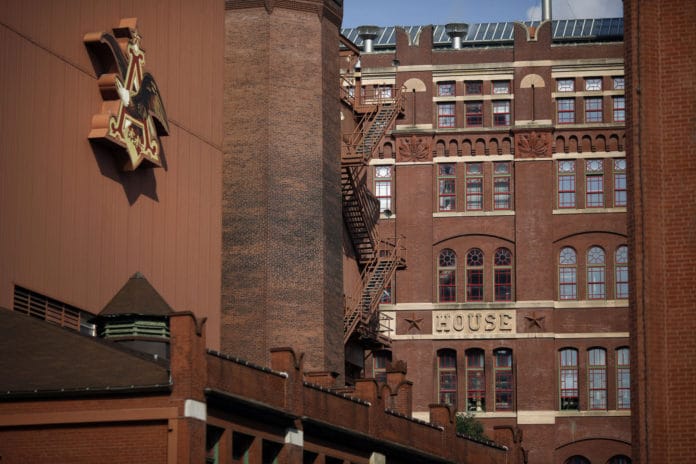Having watched St. Louis shrink for almost 60 years, Steve Pohlman is resigned to the fate of takeover target Monsanto Co. He ticks off the long list of home-grown companies that have disappeared or been acquired and squeezed, from McDonnell Douglas to Trans World Airlines to Anheuser-Busch. At this point, what’s one more?
“It’s all kind of inevitable. They’re systematically disabling the middle class,” says Pohlman, who runs Off Broadway, a nightclub a few blocks from the 141-year-old Anheuser-Busch brewery. A Bernie Sanders fan, Pohlman blames a greedy corporate America and a complicit U.S. government. “The way we let big businesses run wild, that’s what you end up with, and that’s what St. Louis has ended up with.”
It’s become a city of subtraction, a loser in the jagged recovery that factors heavily in the presidential race. The results of March primary were reflections of the mood in urban areas with liberal bents and cast-down economies: Candidates viewed as outsiders were most popular. Donald Trump, the presumptive Republican nominee, won the metropolitan area’s eight counties, while Democratic contender Sanders grabbed six and frontrunner Hillary Clinton took two.
“The psychological impact of exits and takeovers here has been brutal,” says Kenneth Warren, a St. Louis University pollster and political scientist. “Donald Trump says we don’t win at anything anymore, and that connects with the plight of a lot of people. St. Louisans can certainly relate to that because it seems like we don’t win at anything.”
St. Louis has been contracting since 1950, and the pace has accelerated in the past 20 years. What people point to as the beginning of the big descent came in 2008, when Belgium’s InBev bought Anheuser-Busch, putting 2,000 locals out of work, bruising Gateway City pride and creating a beer-making behemoth with headquarters 4,000 miles away. Monsanto, a mainstay since 1901 that employs about 3,000 in the area, could be next, if a $62 billion bid by Bayer of Germany wins out.
It’s already been a rough year, with the Chapter 11 bankruptcy filing in April by locally based Peabody Energy Corp., the world’s largest coal producer. When the National Football League approved the Rams’ move back to Los Angeles after 20 years, owner Stanley Kroenke said any team stupid enough to locate in Missouri’s second-largest city “will be well on the road to financial ruin.” Even the beloved St. Louis Cardinals are mired in third place in their Major League Baseball division, losing almost as many as they’ve won.
“The large businesses are disappearing,” says William Rogers, an economist at the University of Missouri St. Louis. What’s left is a “small-ball” economy.
Detroit may epitomize for most Americans the Midwestern city that tied its fortunes to withering 20th century industries, but St. Louis is in an unhappy class of its own, distinguished by the diversity of companies that have been swallowed up or eradicated. And Missouri, once a bellwether in politics, has come to signify the urban-rural divide in the United States, with Republicans in the statehouse driving a conservative agenda on cultural issues and taxes while Democrats control big cities and grapple with the effects of globalization and corporate downsizing. (Clinton and Trump narrowly won the state in the primaries.)
The Cats Meow, in a former synagogue near Anheuser-Busch, used to open at 6 a.m. to accommodate workers getting off the overnight shift; now taps don’t flow until 9:30 a.m. Bartender Liz Janowski says while the place remains fairly busy, “there aren’t as many people with the fat expense accounts.”
There just aren’t as many people of any kind. St. Louis, with an estimated 316,000 residents last year, has lost roughly half of its population since 1970. Since then, in the metro area of about 2.8 million, incomes have been diluted. Rogers says the average salary today is 5 percent below the national average; 46 years ago it was 10 percent above.
Indicators are everywhere. Since 2002, traffic at Lambert St. Louis International Airport has dropped in half, according to government data. Even Cleveland hasn’t had it that bad, with a 30 percent fall. Last week, Fitch Ratings slashed the city’s credit rating three steps to A-, four levels above junk.
Fitch noted the 29 percent poverty rate is almost double the national average. There are other distressing data. St. Louis had the nation’s highest murder rate in 2014, the last period for which national statistics are available. That was the year of the unrest in Ferguson, a suburb, after an unarmed black man was shot and killed by a police officer.
As Detroit has found, there can be an upside to a down economy: St. Louis is emerging as an alternative for companies interested in reasonable housing prices for their employees. “When businesses come here, they see the cost of living relative to the coasts as really attractive,” says Sheila Sweeney, chief executive officer of the St. Louis Economic Development Partnership.
St. Louis scored a win last week, when the federal government finalized plans to build a $1.8 billion complex of the National Geospatial-Intelligence Agency on the north side. That preserves 3,100 jobs now at the NGA’s existing site, across from the brewery.
But at Off Broadway, Pohlman sees the city on a course that seems irreversible.
“My dad worked at McDonnell Douglas for 40 years and raised a family,” and those days are long gone, he says. Before Boeing Co. bought the aerospace company in 1997, it employed more than 20,000 in the area, and today only about 14,000. Pohlman doesn’t like the calculus going forward. “People say that if you own a music venue and bar like me, you’re set. But if people don’t have money, they don’t come in.”






